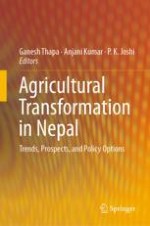2019 | OriginalPaper | Buchkapitel
8. Seed Sector Development in Nepal: Opportunities and Options for Improvement
verfasst von : Devendra Gauchan
Erschienen in: Agricultural Transformation in Nepal
Verlag: Springer Singapore
Aktivieren Sie unsere intelligente Suche, um passende Fachinhalte oder Patente zu finden.
Wählen Sie Textabschnitte aus um mit Künstlicher Intelligenz passenden Patente zu finden. powered by
Markieren Sie Textabschnitte, um KI-gestützt weitere passende Inhalte zu finden. powered by
